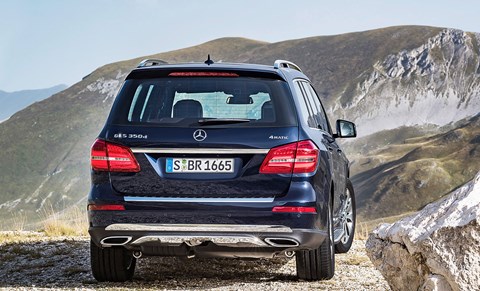► We drive the all-new Mercedes GLS
► It’s bulky and bus-like, but utterly brilliant
► Ticks the boxes without ticking the option boxes
In an Austrian ski lift station temporarily brought to corporate heel in the interests of trespassing Mercedes’ new GLS a scant few kilometres across the sub-zero grounds of an ibex kindergarten, pride of place goes to an art deco fanlight-fashioned display of the company’s 37-strong SUV model range.
That’s right: thirty seven. Granted, five specimens still lurk under artfully slung kerchiefs, awaiting stiletto-abetted reveal at some future, 1:43 scale motor show, but the remainder already constitute compelling evidence that those of us suffering increasingly from SUV compassion fatigue appear not in any way to represent the global groundswell.
All of which leaves me somewhat surprised to report that, rather than instantly dismissing it as an expensive, five-metre plus, two-and-a-half-tonne redundancy – a whale shark amidst a substantial shoal of pilot fish siblings – I rather fell for the GLS.
Granted, moored alongside the land yacht elegance of the pricier Range Rover, the GLS presents as rather an ox of a box – attempts at styling restricted to the obligatory Mercedes nose job and twin exhausts which, on the V6 turbodiesel variant I drove, are fakes.
Nor does the somewhat old-school interior exactly blow the ocular frock up, lacking either the chunky homogeny of a Range Rover or the crisp, virtual cunning of a Q7. However, with JLR’s multimedia electronics still too cheaply sourced and Audi now taking firmly counterintuitive strides in the wrong direction with same, GLS cabin architecture is a long soak in a warm, analogue bath of functional familiarity. And a blissfully comfortable place to be, to boot.
There’s stacks of second-row seating space, and – back and base thereof being a one-touch doddle, sequentially spring-folded to gain access – you have to make it as far south as the GLS’s third row before any hint of squeeze enters the equation. Even so, legroom for those over six feet tall the only issue, this is about the best steerage accommodation on offer.
Both mated to nine-speed automatic transmissions driving all four wheels, only two engine variants will make it to these shores; this 3.0-litre V6 turbodiesel and, unavailable for selection today, the 5.5-litre V8 of the AMG 63.
Good for 254bhp and 475lb ft, the former makes a surprisingly decent fist of shifting this leviathan’s 2455kg, dispatching 62mph in 7.8 seconds and never really feeling short of breath thereafter. Credit for this must largely go to the outstandingly oleaginous transmission which puts JLR’s huntin’, huntin’ and huntin’ ZF-sourced effort to shame.
This engagingly sleazy performance is accompanied by nicely pitched noises off from the engine bay, and – freed by the existence of the GLE from the risk of a dubious, ‘sporty’ soubriquet – positively lounge lizard levels of ride comfort and quietness.
This is one of the few cars on the market heavy enough to properly pestle those pestilential nuggets out of air suspension, and the resultant waft – allied to recording studio levels of sound deadening – elicits a sense of splendid isolation from the great unwashed superior even to that offered by a Range Rover.
Blue Riband progress interrupted by the unseemly need to occasionally turn the wheel, weight management proves less of an issue than anticipated thanks to the adoption here of one essential option: £2795 worth of active anti-roll bars, which make a highly respectable fist of shackling the inevitable impulse to teeter through bends without detriment to straight-line schmooze.
The need for active anti-roll is here exacerbated by the baffling absence of an Audi-style Auto setting amongst the selectable drive modes. For, whilst Sport mode does sharpen turn-in and lob artificial weight at the helm, it’s a tad too detrimental to that sublime ride quality to pass muster for any length of time. Besides, it’s entirely apposite that a car of this size should remind the driver of its mass by rolling somewhat when cornering. Moreover, even in Comfort mode, body control is excellent.
The brakes, too, make it their business to remind you of the mass underfoot; not in terms of outright retardation but, rather, in the last-minute call for an extra shove to wash away the very lowest speeds, making urban progress somewhat grabby until mastered.
With the low-ratio transfer box, locking differential and extra ground clearance of the £1985 off-road pack the only other option temptation, the cheapest GLS you can buy is a rare commodity indeed: a Mercedes that ticks all the boxes without the need to tick another £20,000 worth of boxes.

The specs: Mercedes-Benz GLS 350d 4MATIC AMG Line
Price: £69,100
Engine: 2987cc turbodiesel V6, 254bhp @ 3400rpm, 457lb ft @ 1600rpm
Transmission: Nine-speed auto, all-wheel drive
Performance: 7.8sec 0-62mph, 138mph, 37.2mpg, 199g/km CO2
Weight: 2455kg
On Sale: March 2016
Up against
Better than: Volvo XC90 – Over-firm ride and truck-like hooter
Worse than: Range Rover – But only in looks and off-road ability
We’d buy: Mercedes GLS – Because you don’t have to look at it when you’re in it
Love: Comfort, ride quality, analogue luxury
Hate: Packing crate couture, low-speed braking
Verdict: The best Mercedes SUV by far
Rating: ****
Read more from the March 2016 issue of CAR magazine